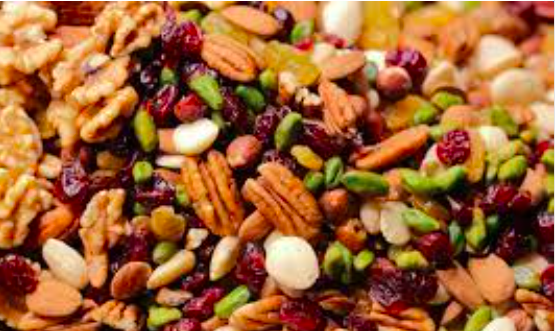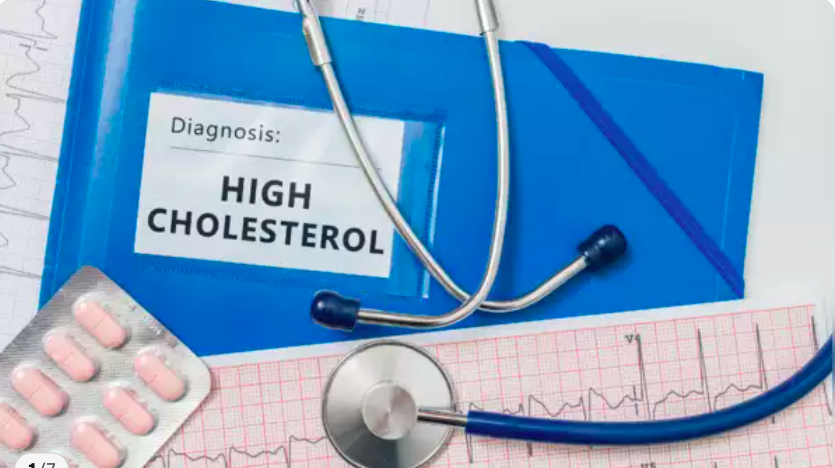Health
7 Delicious and Healthy High-Fiber Snacks for Weight Loss

In the quest for effective weight loss, incorporating high-fiber snacks into your diet can be a game-changer. Not only do they keep you feeling fuller for longer, but they also provide numerous health benefits.
To assist you in your weight loss journey, we have curated a list of 7 delectable and nutritious high-fiber snacks that are both satisfying and beneficial for your body. Let’s delve into these delectable recipes that will help you shed those extra pounds.
Crunchy Roasted Chickpeas
Chickpeas, a fiber-rich legume, is the star ingredient of this crunchy and flavorful snack. Simply toss cooked chickpeas with olive oil and your choice of spices, such as paprika, cumin, or garlic powder. Roast them in the oven until crispy, and you’ll have a protein-packed and high-fiber snack that beats traditional chips any day.
Avocado and Tomato Salsa with Whole Wheat Pita
This refreshing salsa combines the creaminess of the avocado and the tanginess of tomatoes, creating a guilt-free and delicious snack. Dice ripe avocados and tomatoes, and mix them with freshly squeezed lime juice, chopped cilantro, and a hint of salt. Serve it with whole wheat pita bread for an extra dose of fiber.
Greek Yogurt with Berries and Chia Seeds
Greek yogurt is not only a protein powerhouse but also a great source of dietary fiber. Pair it with antioxidant-rich berries and a sprinkle of chia seeds for a wholesome and filling snack. The combination of creamy yogurt, sweet berries, and crunchy chia seeds will tantalize your taste buds while helping you stay on track with your weight loss goals.
Crunchy Vegetable Sticks with Hummus
When the midday snack cravings hit, reach for a plate of crunchy vegetable sticks accompanied by a tangy hummus dip. Carrots, celery, bell peppers, and cucumbers are excellent choices. This low-calorie, high-fiber snacks will keep you satisfied and provide essential nutrients, all while aiding in weight loss.
Baked Apple Chips
Satisfy your sweet tooth while keeping your weight loss goals intact with this healthy twist on traditional apple chips. Slice apples thinly, sprinkle them with cinnamon, and bake them in the oven until crispy. These guilt-free chips are rich in fiber and nutrients, making them a perfect snack option.
Fiber plays a crucial role in weight management. It aids in digestion, promotes a feeling of fullness, and helps regulate blood sugar levels. By incorporating high-fiber snacks into your diet, you can curb cravings, reduce overeating, and maintain a healthy weight.
Now, let’s explore the top 7 high-fiber snack recipes that will not only tantalize your taste buds but also support your weight loss goals.
Quinoa and Black Bean Salad
Quinoa is a nutrient-dense grain that is high in fiber and protein. Combine cooked quinoa with black beans, and diced vegetables such as bell peppers, tomatoes, and red onions, and toss them with a zesty dressing made from lemon juice, olive oil, and herbs. This refreshing and filling salad is not only delicious but also provides a good amount of fiber, helping you stay satiated and aiding in weight loss.
Baked Apple Chips
Spinach and Feta Stuffed Mushrooms
Mushrooms are low in calories and a good source of dietary fiber. For this tasty snack, remove the stems from large mushrooms and fill them with a mixture of sautéed spinach, crumbled feta cheese, and breadcrumbs.
Place the stuffed mushrooms on a baking sheet and bake them at 375°F (190°C) for approximately 15-20 minutes until the mushrooms are tender and the filling is golden brown. These stuffed mushrooms are not only visually appealing but also offer a delightful combination of flavors and textures while providing a fiber boost.
Conclusion
Incorporating high-fiber snacks into your weight loss journey is a smart and effective strategy. The 7 delicious and healthy recipes mentioned above offer a variety of flavors, textures, and nutrients while being rich in fiber.
From crunchy roasted chickpeas to refreshing avocado salsa and satisfying quinoa salad, these snacks will keep you feeling fuller for longer, curb your cravings, and support your overall weight loss goals.
Remember to choose whole, unprocessed ingredients and make these snacks a regular part of your balanced diet for optimal results. By prioritizing high-fiber snacks, you can nourish your body, improve digestion, and achieve your desired weight. Enjoy these flavorful and nutritious snacks while taking a step closer to a healthier lifestyle.
References:
- Mayo Clinic. (2022). Dietary fiber: Essential for a healthy diet. Retrieved from https://www.mayoclinic.org/healthy-lifestyle/nutrition-and-healthy-eating/in-depth/fiber/art-20043983
- Harvard T.H. Chan School of Public Health. (2021). Fiber. Retrieved from https://www.hsph.harvard.edu/nutritionsource/carbohydrates/fiber/
Health
6 Daily Habits to Naturally Lower Cholesterol Levels
Health
Understanding the Rapid Spread of Monkeypox’s New Strain Clade 1b

Understanding the Rapid Spread of Monkeypox’s New Strain Clade 1b: Key Facts on Transmission, Symptoms, Severity, and Vaccination
Monkeypox, a viral disease with symptoms resembling smallpox, has recently gained attention due to the emergence of a newstrain, Clade 1b.
This article delves into the essential details about this new variant, including how it spreads, its symptoms, its severity, and the current state of vaccinations.
Our goal is to provide a comprehensive and clear understanding of this evolving situation, enabling readers to stay informed and prepared.
Monkeypox, once a rare and somewhat obscure disease, has recently become a significant public health concern due to the emergence of new strains.
Among these, Clade 1b has been noted for its rapid spread and distinct characteristics.
As we navigate through the complexities of this variant, it is crucial to grasp the fundamentals of its transmission, symptoms, severity, and preventive measures, including vaccination.
Understanding Monkeypox Clade 1b
What is Monkeypox?
Monkeypox is a zoonotic virus belonging to the Orthopoxvirus genus, which also includes smallpox.
First identified in monkeys, it can infect humans through close contact with infected animals or individuals.
While it shares similarities with smallpox, monkeypox tends to be less severe and less transmissible.
Clade 1b Overview
Monkeypox has several clades (strains), with Clade 1b being the most recent and notable for its rapid spread.
This strain has shown increased transmissibility compared to previous clades, raising concerns among public health officials.
Transmission of Clade 1b
Modes of Transmission
Clade 1b spreads primarily through:
- Direct Contact: Contact with bodily fluids, skin lesions, or contaminated surfaces of an infected person.
- Respiratory Droplets: Prolonged face-to-face interaction can lead to transmission through respiratory droplets.
- Animal Contact: Infected animals, particularly rodents and primates, can transmit the virus to humans.
Environmental Factors
Transmission rates can also be influenced by environmental factors such as:
- Crowded Living Conditions: Higher transmission rates are observed in densely populated areas.
- Sanitation Practices: Poor hygiene and sanitation can facilitate the spread of the virus.
Symptoms of Monkeypox Clade 1b
Early Symptoms
The symptoms of Clade 1b may resemble those of other viral infections, making initial diagnosis challenging.
Early symptoms include:
- Fever: A sudden onset of high temperature.
- Headache: Severe headaches that can persist for days.
- Muscle Aches: Generalized muscle pain and discomfort.
- Fatigue: Extreme tiredness and weakness.
Rash and Skin Lesions
A defining feature of monkeypox is the rash, which typically progresses through several stages:
- Macules: Flat, discolored spots on the skin.
- Papules: Raised bumps.
- Vesicles: Fluid-filled blisters.
- Pustules: Pus-filled lesions that eventually crust over.
Severe Symptoms
In more severe cases, symptoms may include:
- Encephalitis: Inflammation of the brain, leading to neurological symptoms.
- Pneumonia: Infection of the lungs that can cause difficulty breathing.
- Secondary Infections: Bacterial infections that may complicate the healing process.
Severity of Clade 1b
General Outlook
Clade 1b has been associated with a higher transmission rate and more severe outcomes compared to other strains. However, the overall severity can vary widely among individuals.
Factors influencing severity include:
- Immune System Status: Individuals with weakened immune systems or pre-existing conditions may experience more severe symptoms.
- Age: Young children and elderly individuals are at higher risk of severe illness.
- Timeliness of Medical Care: Early medical intervention can significantly affect the outcome.
Mortality Rates
The mortality rate for Clade 1b is currently under study, but initial data suggest it may be higher than previous strains. Prompt medical attention and supportive care are crucial in reducing the risk of severe outcomes.
Vaccination and Prevention
Current Vaccines
Vaccination is a key strategy in controlling the spread of monkeypox.
The following vaccines are relevant:
- Smallpox Vaccine: The smallpox vaccine is effective against monkeypox due to the similarities between the viruses. It provides protection for those who have been recently vaccinated or who received it in the past.
- Monkeypox-Specific Vaccine: Research is ongoing into vaccines specifically targeting monkeypox, with several candidates showing promise in trials.
Vaccination Recommendations
Public health authorities recommend vaccination for:
- Healthcare Workers: Individuals who are at higher risk due to their profession.
- High-Risk Populations: People in areas experiencing outbreaks or those with frequent exposure to infected individuals.
Preventive Measures
In addition to vaccination, preventive measures include:
- Good Hygiene: Regular handwashing and use of hand sanitizers.
- Avoiding Contact: Minimizing close contact with individuals displaying symptoms or with infected animals.
- Isolation: Infected individuals should isolate themselves to prevent the spread of the virus.
Conclusion
The emergence of Monkeypox Clade 1b represents a significant challenge to global health. Its increased transmissibility and potential for severe outcomes highlight the importance of staying informed and proactive.
By understanding its transmission, symptoms, and preventive measures, individuals and communities can better protect themselves and mitigate the impact of this new strain.
FAQs
1. What makes Clade 1b different from other monkeypox strains?
Clade 1b is noted for its increased transmissibility and potentially more severe outcomes compared to other strains.
It spreads faster and may lead to more serious health issues, necessitating closer monitoring and enhanced preventive measures.
2. How can I tell if I have monkeypox or another viral infection?
Monkeypox often begins with flu-like symptoms and progresses to a distinct rash.
If you experience these symptoms, especially if you’ve been in contact with someone who has monkeypox or are in an outbreak area, seek medical advice for accurate diagnosis and testing.
3. Is the smallpox vaccine effective against Monkeypox Clade 1b?
Yes, the smallpox vaccine offers protection against monkeypox, including Clade 1b, due to the similarities between the two viruses.
However, its effectiveness may vary based on factors such as time since vaccination and individual health conditions.
4. Are there any new vaccines specifically for monkeypox?
Research is ongoing to develop and approve vaccines specifically targeting monkeypox.
Several candidates are in various stages of clinical trials, with some showing promising results in enhancing protection against monkeypox strains, including Clade 1b.
5. What should I do if I suspect I have monkeypox?
If you suspect you have monkeypox, contact a healthcare provider immediately. They can guide you through testing, diagnosis, and appropriate care.
In the meantime, practice good hygiene and avoid close contact with others to prevent spreading the virus.
References:
Health
Understanding the Low Risk of Mpox Outbreak in India and Our Preparedness Measures

-

 Trending Stories1 year ago
Trending Stories1 year agoCDC: 1 in 4 Americans Still COVID-Free by End of 2022
-

 Health5 years ago
Health5 years agoMeghan Trainor Shares Motivational New Song ‘Blink’
-

 Health2 years ago
Health2 years agoHow Long Does Monkey Pox Last Before It Surfaces in the Body?
-

 Health2 years ago
Health2 years agoWhat Causes Swollen Body? Understanding Edema and its Triggers
-

 Health4 months ago
Health4 months agoHow Do Pawpaw Seeds Support Cardiovascular Health?
-

 Health3 years ago
Health3 years agoNutrition and the Importance of a Fitness Program – 3 Things to Know
-

 Health3 years ago
Health3 years ago5 Weird Reasons Why Pimples Disappear After Marriage
-

 Health2 years ago
Health2 years agoHealth Benefits Of Pawpaw Seed? 7 Things To Know






